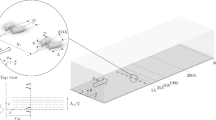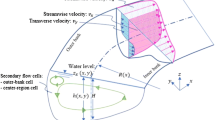Abstract
In highly transient turbulent flows, the energy cascade and related dissipation rate of energy are key factors which must be modeled precisely to obtain the accurate computational predictions. The flow in diesel engines specifically during compression stroke is quite transient, so most commonly used eddy viscosity based turbulence models fail to predict the transitional characteristics of these types of flow. This paper focuses on performance appraisal of three versions of Reynolds stress turbulence models in resolving non-equilibrium features and transitional characteristics of turbulent in-cylinder engine flows. Results indicate that although these turbulence models give the same prediction of averaged quantities of turbulent flows (i.e. mean flow kinetic energy), their results are totally different in calculating non-equilibrium features and the turbulent length scales. According to calculated results, incompressible Launder–Reece–Rodi and Naot second-moment closure models give unreal estimations of the turbulent integral length scale during compression stroke, while the modified Launder–Reece–Rodi model predictions have more similarity with physical trends.

Similar content being viewed by others
Abbreviations
- a i j :
-
Reynolds stress anisotropy
- C D :
-
Droplet drag coefficient
- C P :
-
Specific heat capacity (J K−1)
- D d,k :
-
Droplet diameter (m)
- D i j :
-
Reynolds stress diffusion (kgm−1 s−3)
- f :
-
Evaporated fuel mass (kg)
- h :
-
Gas phase enthalpy (J kg−1)
- k :
-
Turbulent kinetic energy (m2 s−2)
- k d :
-
Turbulence effects of gas phase on droplets (s−1)
- N d,k :
-
Number of droplets in a parcel
- n i :
-
Normal-to-the-wall unit vector
- P :
-
Near wall temperature field correction function
- P :
-
Static pressure (pa)
- P i j :
-
Reynolds stress production (kgm−1 s−3)
- \({\dot{{q}_{\rm w}}}\) :
-
Wall heat flux (W)
- r :
-
Radial coordinate (m)
- r d :
-
Droplet radial coordinate (m)
- S hd :
-
Droplet source term in gas phase energy equation (Jm−3 s−1)
- S i j :
-
Mean flow strain rate (s−1)
- S md :
-
Converted mass from liquid to gas (kg s−1)
- S u :
-
Droplet source term in gas phase axial momentum equation (kgm−2 s−2)
- S ud :
-
Droplet source term in gas phase axial momentum equation (kgm−2 s−2)
- S v :
-
Droplet source term in gas phase radial momentum equation (kgm−2 s−2)
- S vd :
-
Droplet source term in gas phase radial momentum equation (kgm−2 s−2)
- t :
-
Time (s)
- T k,D :
-
Droplet temperature (K)
- T w :
-
Wall temperature (K)
- T + :
-
Non-dimensional temperature
- u :
-
Gas phase axial velocity (ms−1)
- u d :
-
Droplet axial component velocity (ms−1)
- U + :
-
Non-dimensional velocity
- u′:
-
Gas phase axial component velocity fluctuations (ms−1)
- \({\overline {{{u}^{\prime}{u}^{\prime}}}}\) :
-
Reynolds stress (m2 s−2)
- \({\overline {{{u}^{\prime}{v}^{\prime}}}}\) :
-
Reynolds stress (m2 s−2)
- U τ :
-
Frictional velocity (ms−1)
- v :
-
Gas phase radial component velocity (ms−1)
- V rel :
-
Relative velocity (ms−1)
- v′:
-
Gas phase radial component velocity fluctuations (ms−1)
- \({\overline {{{v}^{\prime}{v}^{\prime}}}}\) :
-
Reynolds stress (m2 s−2)
- x :
-
Axial coordinate (m)
- x d :
-
Droplet axial coordinate (m)
- y + :
-
Non-dimensional distance from wall
- θ :
-
Void fraction
- ρ :
-
Gas phase density (kgm−3)
- μ :
-
Gas phase viscosity (kgm−1 s−1)
- \({\varepsilon}\) :
-
Eddy dissipation rate (m2 s−3)
- \({\Pi _{{\rm ij}}}\) :
-
Reynolds stress pressure–strain correlation
- \({\Pi _{{\rm ij1}}}\) :
-
Reynolds stress pressure–strain “slow term” correlation (kgm−1 s−3)
- \({\Pi _{{\rm ij2}}}\) :
-
Reynolds stress pressure–strain “rapid term” correlation (kgm−1 s−3)
- \({\Pi _{{\rm ijw}}}\) :
-
Reynolds stress pressure–strain “wall-echo” (kgm−1 s−3)
- \({\Omega _{{\rm ij}}}\) :
-
Rotational term (s−1)
- τ w :
-
Wall shear Stress (kgm−1 s−2)
- σ h,t :
-
Turbulent Prandtl number
- σ h :
-
Prandtl number
- μ t :
-
Eddy viscosity (kgm−1 s−1)
- ρ d :
-
Droplet density (kgm−3)
References
Bradshaw P.: Compressible turbulent shear layers. Ann. Rev. Fluid Mech. 9, 33–54 (1977)
Morkovin, M.V.: Effects of compressibility on turbulent flows. In: Favre, A. (eds.) Mecanique de la Turbulence, pp. 367–380. Éditions du Centre National de la Recherche Scientifique, Paris (1962)
Morkovin, M.V.: Mach number effects on free and wall turbulent structures in light of instability flow interactions. In: Gatski, T.B.; Sarkar, S.; Speziale, C.G. (eds.) Studies in Turbulence. pp. 269–284. Springer, Berlin (1992)
So R.M.C., Gatski T.B., Sommer T.P.: Morkovin hypothesis and the modeling of wall-bounded compressible turbulent flows. AIAA J. 36, 1583–1592 (1998)
Smits A.J.: Turbulent boundary layer structure in supersonic flow. Philos. T. R. Soc. A 336, 81–93 (1991)
Donovan J.F., Spina E.F., Smits A.J.: The structure of supersonic turbulent boundary layers subjected to concave surface curvature. J. Fluid Mech. 259, 1–24 (1994)
Blaisdell G.A., Mansour N.N., Reynolds W.C.: Compressibility effects on the growth and structure of homogeneous turbulent shear flows. J. Fluid Mech. 256, 443–485 (1993)
Sarkar S.: The stabilizing effect of compressibility in turbulent shear flows. J. Fluid Mech. 282, 163–186 (1995)
Hamba F.: Effects of pressure fluctuations on turbulence growth in compressible shear flow. Phys. Fluids 11, 1623–1635 (1999)
Hitoshi F., Yuichi M., Chuichi A.: A Turbulence model for the pressure–strain correlation term accounting for the effects of compressibility. Trans. Jpn. Soc. Mech. Eng. B 640, 3906–3911 (1999)
Park C.H., Park S.O.: A compressible turbulence model for pressure–strain correlation. J. Turbul. 6, 1–24 (2005)
Fu, S.; Haung, S.Y.: Modeling the compressibility effect with second-moment closure. Comput. Mech. In: Proceedings of International Symposium on Computational Mechanics. Beijing, China, pp. 241–259 (2007)
Siow, Y.K.: A Reynolds-stress turbulence model in the KIVA code for engine simulation. PhD thesis. Michigan Technological University, Michigan, USA (2003)
Dinler N., Yucel N.: Combustion simulation in a spark ignition engine cylinder: effects of air–fuel ratio on the combustion duration. Therm. Sci. 14, 1001–1012 (2010)
Jafarmadar, S.; Heidarpoor, V.: Numerical studies of spray breakup in a gasoline direct injection (GDI) engine. Therm. Sci. doi:10.2298/TSCI101025047J (2011)
El Tahry S.H.: k-\({\varepsilon}\) Equations for compressible reciprocating engine flows. AIAA J. Energy 7, 345–353 (1983)
Coleman G.N., Mansour N.N.: Modeling the rapid spherical compression of isotropic turbulence. Phys. Fluids 3, 2255–2259 (1991)
Tanner, F.X.; Zhu, G.S.; Rietz, R.D.: A Turbulence Dissipation Correction to the k-epsilon model and its effect on turbulence length scales in engine flows. In: Proceedings of International Multidimensional Engine Modeling User’s Group Meeting at the SAE Congress, Detroit, USA (2001)
Maozhao X., Wence S., Fang L.: Study on the rapid pressure–strain rate in the second-moment closure for turbulent flows undergoing strong compression and large distribution. Comput. Fluids 32, 275–286 (2003)
Yang S.L., Siow Y.K., Teo C.Y., Hanjalic K.: A KIVA Code with Reynolds-stress model for engine flow simulation. J. Energy 30, 427–445 (2005)
El Wakil, M.M.; Ueyhara, O.A.; Myers, F.S.: A theoretical investigation of the heating-up period of injected fuel droplets vaporizing in air. NACA Technical Note 3179 (1954)
Gavaises, M.: Modeling of Diesel Fuel Injection Processes. PhD thesis, Imperial College of Science and Technology and Medicine. University of London, London, UK (1996)
Rietz, R.D.; Diwakar, R.: Effect of Drop Breakup on Fuel Sprays. SAE No. 860469 (1986)
Gosman A.D., Ioannides E.: Aspects of computer simulation of liquid-fuelled combustors. J. Energy 7, 482–490 (1983)
Khaleghi, H.; Watkins, A.P.: Calculation of 3D diesel spray into curvilinear piston bowls. In: Proceedings of ASME Symposium On Automotive Engine Technology. Paper No. 87-FE-I, Dallas, USA (1987)
Gosman, A.D.; Johns, J.R.; Watkins, A.P.: Computer Analysis of Fuel–Air Modeling in Direct Injection Engines. SAE No.800091 (1980)
Naot D., Shavit A., Wolfshtein M.: Interaction between components of the turbulent velocity correlation tensor. Israel J. Technol. 8, 259–269 (1970)
Hanjalic K.: Advanced turbulence closure models: a view of current status and future prospects. Int. J. Heat Fluid Fl 15, 178–203 (1994)
Khaleghi H., Ganji D.D., Omidvar A.: Comparison of various droplet breakup models in gas–liquid flows in high pressure environments. Iran J. Sci. Technol. B 32, 385–400 (2008)
Yule, A.J.; Mo, S.L.; Tham, S.Y.; Aval, S.M.: Diesel spray structure. In: Proceedings of 3rd International Conference on Liquid Atomization and Spray Systems. Paper No. 8555. Imperial College of Science and Technology, England, London (1985)
Khaleghi, H.; Fallah, E.: Iterative and non-iterative solutions of engine flows using ASM & k-\({\varepsilon}\) turbulence models. In: Proceedings of 11th Annual of CFD Conference, Canada, Ontario (2003)
Author information
Authors and Affiliations
Corresponding author
Rights and permissions
About this article
Cite this article
Zoka, H.M., Omidvar, A. & Khaleghi, H. On the Performance of Various Reynolds Stress Models in Resolving Non-equilibrium Features of Turbulent In-cylinder Engine Flows. Arab J Sci Eng 38, 2891–2900 (2013). https://doi.org/10.1007/s13369-012-0477-x
Received:
Accepted:
Published:
Issue Date:
DOI: https://doi.org/10.1007/s13369-012-0477-x




